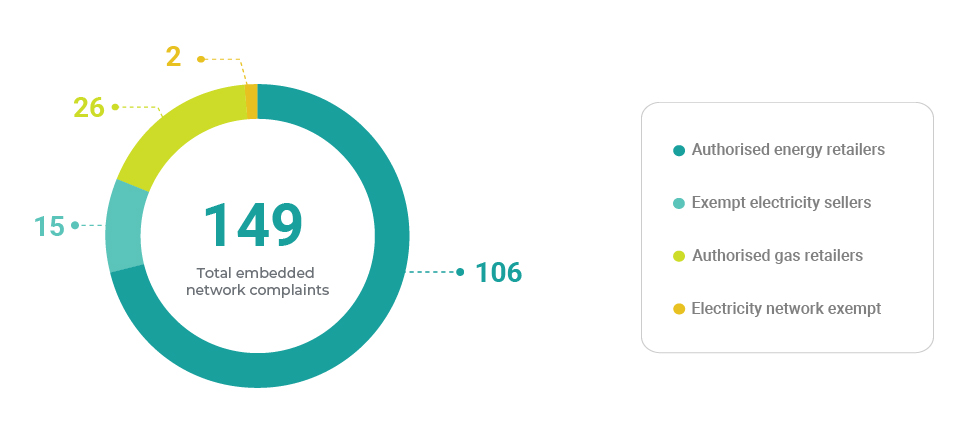-
Home
-
Publications and submissions
-
Reports
-
EWON Insights
-
EWON Insights Jul-Sep 2021
- Embedded network complaints and case studies
Embedded network complaints and case studies
This quarter EWON opened 149 complaints from embedded network customers. These customers were complaining about a range of energy service providers:
- authorised energy retailers: 106
- authorised gas retailers: 26
- exempt electricity sellers: 15
- exempt electricity networks: 2

EWON closed 139 complaints from customers whose electricity or gas (including hot water) is supplied through an embedded network.
Table 7 -Top 10 core issues for embedded network complaints closed this quarter
| Core complaint issues | Complaints |
|---|---|
| Billing > high > disputed | 55 |
| Billing > backbill | 9 |
| General > energy / water | 5 |
| Billing > tariff > rate | 4 |
| Billing > other | 4 |
| Billing > contract terms > variation in price / terms | 4 |
| Billing > delay | 4 |
| Billing > period | 3 |
| Billing > rebate / concession > error | 3 |
| Customer service > poor service | 3 |
Table 8 - Top 10 issues for embedded network complaints closed this quarter
| All complaint issues | Complaints |
|---|---|
| Billing > high > disputed | 65 |
| Customer service > poor service | 15 |
| Customer service > failure to respond | 13 |
| Billing > backbill | 12 |
| Billing > delay | 9 |
| Billing > period | 8 |
| Billing > account opening > error | 8 |
| Credit > disconnection / restriction > impending | 6 |
| Credit > payment difficulties > current / arrears | 5 |
| Billing > contract terms > variation in price / terms | 5 |
Financial assistance for customers within embedded networks
Whilst the National Energy Customer Framework (NECF) provides protections for residential customers experiencing financial vulnerability, many of these protections are not extended to residential customers that live in an embedded network.
The gap between these consumer protections and availability of resources to assist residents of embedded networks who are experiencing financial vulnerability and those that are connected directly to the grid is too wide.
EWON has long called for any protections and availability of resources to be equal for every eligible customer that holds an energy account in NSW.
For example, currently some embedded network residents have access to NSW Government rebates, however there are additional administrative hurdles in obtaining these rebates and the application process for these customers can be unclear.
Another example of the limits on financial support, is that residents in an embedded network do not have access to financial assistance such as Energy Accounts Payment Assistance (EAPA).
During 2020 and 2021 as part of the NSW Government’s COVID-19 response, EAPA was temporarily extended to customers of authorised energy retailers operating embedded networks. Residents could contact Energy NSW to find out when EAPA was able to be applied to their account.
EWON has always held that EAPA should be expanded on a permanent basis to all customers in NSW that hold an energy account. This should apply to authorised retailers operating an embedded network and to exempt sellers operating embedded networks. The NSW Department of Planning, Industry and Environment has indicated that a future work stream will address this inequity. We look forward to consultation on this important reform.
The following case study demonstrates that anyone can experience financial vulnerability and that retailers should provide additional information about the availability of financial assistance, such as rebates. It also highlights that availability of EAPA would have significantly benefitted the customer.
Financial vulnerability and not being provided with information about rebates
A customer moved into a property in an embedded network in November 2020. When she established an account with the retailer, she provided her pension card details but was told that they would not accept the details. She lived alone at the property and considered she only used a small amount of gas. She disputed her bills with the retailer but was not offered any assistance and was told to use less gas.
The customer had $300 owing on her gas account and was not able to pay this amount. She did not receive any discount on her bills, was not receiving the NSW Gas rebate and tried to apply for EAPA but was unsuccessful because she lived in an embedded network.
We referred the matter to the retailer at a higher level to discuss an affordable payment arrangement. We told the customer that EAPA was not currently available to residents living in an embedded network, however she might be eligible to receive the NSW Gas rebate and provided her with details of how to apply.
Supply issues in embedded networks
Customers that live in an embedded network have no guaranteed service standards, in contrast to electricity customers connected to the grid. These are applied through the terms and conditions of their standard connection contract and the distributor’s licence conditions.
Customers in an embedded network rely on the retailer or park operator to ensure the quality and reliability of supply. The embedded network operator is responsible for the distribution of supply to each individual property.
Embedded network operators are required to comply with the Australian Energy Regulator’s Exempt Selling Guidelines, which requires them to provide residents with two business days’ notice if there is going to be a planned power outage. The following case study illustrates the customer detriment that can occur.
Multiple planned power outages without notification alongside meter exchange and amperage concerns
A customer contacted EWON as she had no power supply at her property. She lived in a residential community and had not received any warning that the power was going to be turned off for a planned power outage. She had recently had multiple planned power outages, all without notification.
We referred the matter to the park operator at a higher level however the customer contacted us again to advise that her meter had just been replaced and she was not able to use as many appliances simultaneously as she had before.
We contacted the park operator who acknowledged that they had not sent notices to the customer prior to turning off the electricity supply and said that after the supply was turned off, they had gone out to notify customers of the outage in person. They would also make sure the appropriate notices were sent for any future planned power outages.
We also asked the park operator about the meter exchange and amperage at the property. The park operator explained that the electrician had indicated that, while the wiring at the property was old, the meter exchange should not affect the amperage at the property.
When we contacted the customer, she advised that the electrician had attended the property with the park operator and had fixed the wiring at the property. She was happy that her concerns had been addressed and that her wiring had been fixed.

